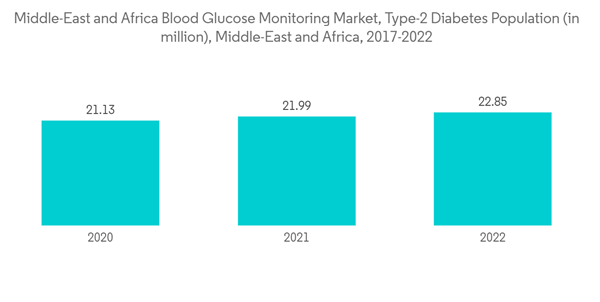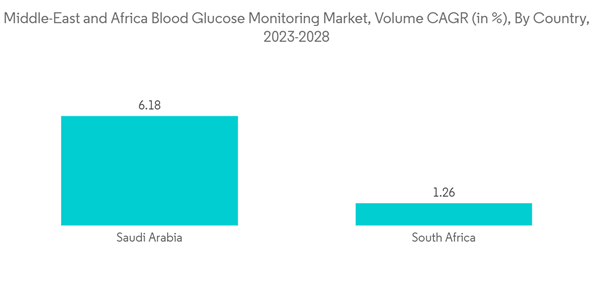Diabetes and COVID-19 have a significant influence on public health not just overseas but also in the Middle East and Africa. In COVID-19 patients, diabetes has been reported to increase the incidence of both fatal infections and serious infections. Because diabetes is one of the primary health issues that is incredibly prevalent in the Middle East and African countries, the present research focused on understanding the epidemiology of COVID-19 in people with diabetes and the initiatives put in place by the governments to decrease its impact.
There is an increasing incidence of lifestyle diseases, such as diabetes, in developing countries that are increasing the demand for blood glucose monitoring devices. The increased awareness about healthcare facilities and preventive care is also supporting the growth of the market. The number of patients relying on self-monitoring blood glucose (SMBG) has increased. Owing to the high-cost constraints associated with continuous glucose monitoring (CGM), self-monitoring by glucometer is more acceptable in the Middle-East and Africa region. These devices help in the early detection of hypo and hyperglycemia conditions, which tend to drive the market for glucose monitoring.
Middle East and Africa Blood Glucose Monitoring Market Trends
Test Strips Accounted for The Highest Market Share in Middle East And Africa Blood Glucose Monitoring Devices Market.
In the Middle East and African blood glucose monitoring market, test strips hold 45% of the share with USD 136 million in revenue. Price is often a significant concern when purchasing blood glucose test strips. Although various countries provide reimbursements for prescribed test strips, the majority of patients have to pay for them out of their own pockets. Africa has experienced a rise in the number of diabetic patients over the past decade. Total diabetes-related health expenditure in Africa is nearly USD 9.5 billion and is expected to almost double by 2045.Governments in the Middle East have seen the threat that diabetes poses and have begun to take action with a number of policies, projects, and programs. In this area, there are still six of the fifteen nations without a national operational action plan for diabetes. Many nations still lack a comprehensive national plan to lower the significant diabetes risk factors of being overweight, obese, and inactive.
National diabetes treatment recommendations have been fully adopted in most areas. Nevertheless, ongoing efforts are being made to reduce diabetes complications. The market will probably continue to rise as a result of the increased incidence of type-2 diabetes, growing genetic risk factors, and the considerations indicated above.
Programs, such as the Base of the Pyramid project, a public-private partnership initiated by Novo Nordisk, aim to increase awareness about diabetes in low- and middle-income countries in Africa. In the Middle East and Africa, due to lifestyle and food habits, blood glucose fluctuations among insulin users are frequent from time to time, and the use of self-monitoring of blood glucose increases. A rise in the diabetic population drives the market by increasing the use of blood glucose monitoring devices.
Obesity is considered one of the major factors contributing to the disease, primarily type-2 diabetes. Also, other factors, such as technological innovations and advancements, provide many conveniences in measuring blood glucose levels. One such advancement in monitoring the blood glucose level is established with continuous glucose monitoring devices. Therefore, due to an increase in the usage of monitoring devices among the type-2 diabetes population, the market is expected to grow.
Saudi Arabia and Iran Together Accounted for over 50% Share in the Middle-East and Africa Blood Glucose Monitoring Devices Market.
Diabetes is one of the mounting health problems the country is facing. Saudi Arabia is ranked among the top three Middle Eastern and African countries with the highest prevalence of diabetes. Saudi Arabia has a 36% market share in the Middle East and Africa for blood glucose monitoring, and Iran is the second-largest market after that.The high sales of blood glucose monitoring devices in Saudi Arabia are due to the growing prevalence of diabetes in the country. The Middle-East countries have high diabetes prevalence, like Saudi Arabia at 24%, Kuwait at 23%, Bahrain at 22%, Qatar at 20%, and the UAE at approximately 19%. Price is often a significant concern when purchasing blood glucose monitoring devices. Although various countries, like Saudi Arabia, Iran, and other countries in the Middle East and Africa, provide reimbursements for prescribed SMBG devices and their components, most patients have to pay for them out of their pockets.
In recent years, diabetes incidence has increased alarmingly throughout the Middle East and Africa. Because of lifestyle changes, the prevalence of diabetes has reached an all-time high. Numerous health issues are related to diabetes. Diabetes patients must make several daily adjustments to keep their blood glucose levels within acceptable ranges. For example, they may need to take extra insulin or consume more carbs.
Therefore, owing to the aforesaid factors, the growth of the studied market is anticipated in the Middle East and Africa regions.
Middle East and Africa Blood Glucose Monitoring Industry Overview
The Middle East and Africa blood glucose monitoring market is highly fragmented, with few major manufacturers boasting a global market presence, while the remaining manufacturers are confined to other local or region-specific manufacturers, and local government initiatives encourage the market.Additional Benefits:
- The market estimate (ME) sheet in Excel format
- 3 months of analyst support
This product will be delivered within 2 business days.
Table of Contents
Companies Mentioned (Partial List)
A selection of companies mentioned in this report includes, but is not limited to:
- Abbott
- F. Hoffmann-La Roche AG
- Johnson & Johnson
- Dexcom
- Medtronics
- Agamatrix Inc.
- Bionime Corporation
- Acon
- Medisana
- Trivida
- I-SENS
- Ascensia
- Rossmax
Methodology

LOADING...










